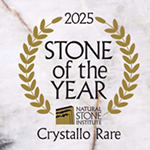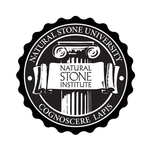R-Value for Natural Stone
Heat always flows from warmer to colder areas. The transfer of heat energy through a solid material is known as conduction. There are certain applications where this heat transfer, or thermal conductivity, of a natural stone becomes an important factor in selecting the best material and design. A stone surround at a fireplace or cooktop, between the heat source and a flammable outer material, is an example where the conductivity of the stone should be carefully determined before selection. Another common application is a heated pavement system, where the thermal conductivity of the stone becomes a factor in determining the system requirements to effectively melt snow and ice from the pavement surface. This bulletin provides the measured values of thermal conductivity (k-value) and thermal resistance (R-value) for the most common natural stone types used in building applications of common stone types.
| Material Type | k-Value (Thermal Conductivity) (W/mK) |
R-Value Equivalent (R)3 (Hr • ft2 • ºF / Btu) |
| Granite (High Value)1 | 1.73 | 0.083 |
| Granite (Low Value)1 | 3.98 | 0.038 |
| Granite (Barre)2 | 2.79 | 0.052 |
| Limestone (High Value)1 | 1.26 | 0.114 |
| Limestone (Low Value)1 | 1.33 | 0.108 |
| Limestone (Salem)2 | 2.15 | 0.067 |
| Marble (High Value)1 | 2.07 | 0.070 |
| Marble (Low Value)1 | 2.94 | 0.049 |
| Marble (Halston)1 | 2.80 | 0.051 |
| Sandstone (High Value)1 | 1.83 | 0.079 |
| Sandstone (Low Value - Berea)2 | 2.90 | 0.050 |
| Quartzite (Sioux)1 | 5.38 | 0.027 |
1.. Holman, J.P. Heat Transfer. 7th ed., New York: McGraw-Hill, 1900. (Appendix A.3)
2. Introduction to Heat Transfer. 2nd ed. New York: John Wiley & Sons, Inc., 1990. (Appendix A)
3. The Thermal Resistance or R-value depends on the thickness of the material. These values have been calculated for a 1" thick dimension stone sample.
The center column in the table above lists values for the thermal conductivity of the natural stone types. The k-value is a measurement of the rate of heat transfer through a solid material. If a material has a k-value of 1.00, it means that 1 square meter of material in a thickness of 1 meter will transfer heat at a rate of 1 watt for every degree Kelvin of temperature difference between opposite faces. A high value indicates the material is more conductive, and a low value means it is more insulating. The right column in the table above lists the R-value equivalent (R) of the stone in 1" thickness as measured in hours by square feet by degrees Fahrenheit per British thermal unit. The high value is the highest test score achieved in a range of samples, and the low value is the lowest test score achieved. This is the accepted method used to measure the insulating value of products.
The Natural Stone Institute thanks Natural Stone Institute Member firm SGS US Testing, Tulsa, Oklahoma, for their guidance and consultation.
This technical bulletin contains general guidelines. The Marble Institute of America and its Member companies are not responsible for any use or misuse that causes damage of any kind, including loss of rights, materials, and personal injury alleged to be caused directly or indirectly by the information contained in this document.












